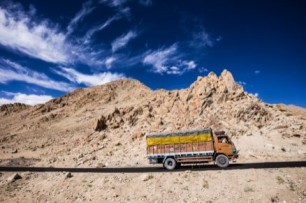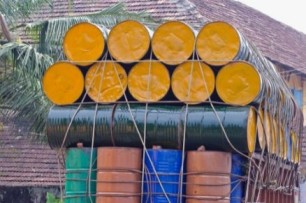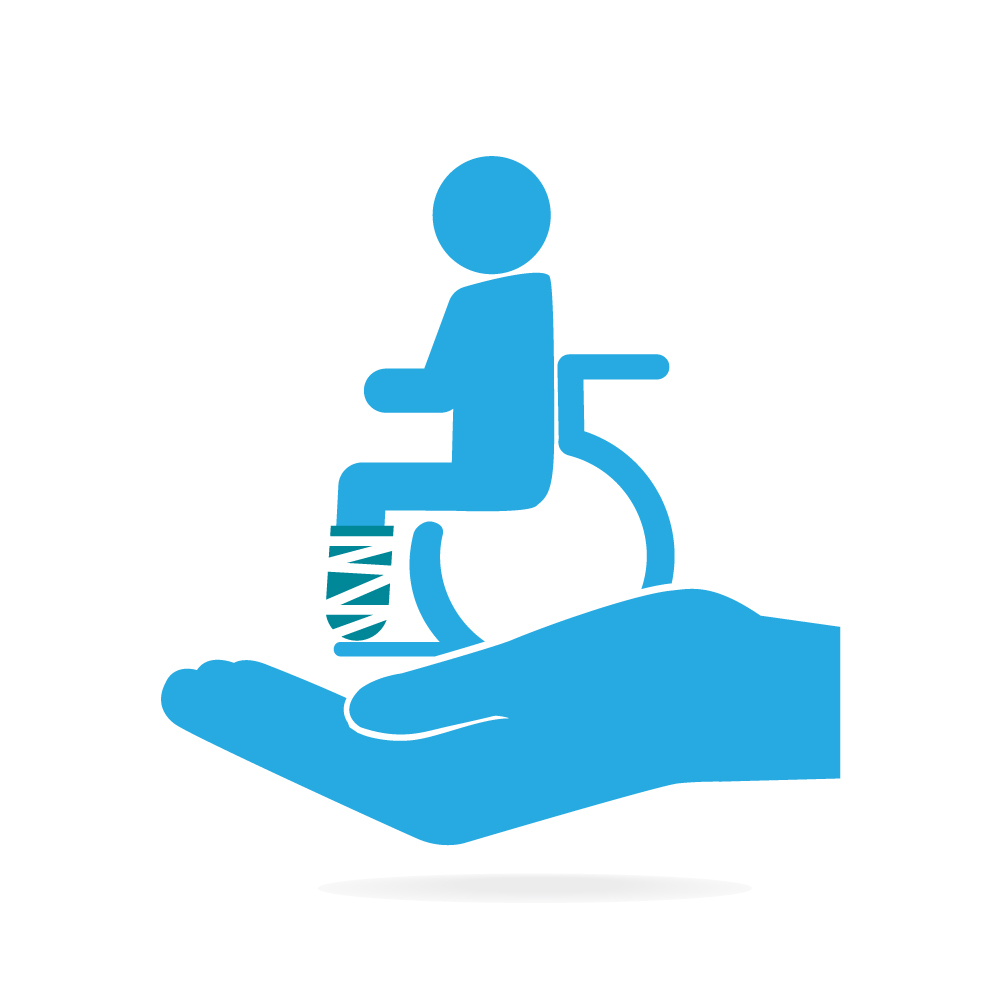General Insurance Blogs, Articles & Updates by - Magma HDI
Have us call you
- RENEW YOUR POLICY
- BUY NEW POLICY

Trekking solo or with a group? Let's clear the air of confusion
"The best view arrives after the hardest trek," and there is no denying that. The beautiful valleys, the breath of fresh air, the stunning views are just a few of the many rewards you get at the end of a trek. We have heard about the experiences of avid trekkers, and each of them, without fail, has mentioned that everyone should go trekking at least once in their lifetime.
Trends show that more and more people are leaning towards new outdoor experiences, and trekking is something they want to enjoy. While choosing a destination isn't challenging, zeroing in on the other aspects of your travel becomes essential. One crucial question is whether to travel solo or in groups. Today we will try to shed light on both of these to help you make an informed decision before your next trip.
Why travel solo?
People have often associated trekking with catharsis. They enjoy the peace, quiet, and sometimes the mini-adventures that come with it. Navigating through unknown roads, climbing treacherous terrains, cooking your food, and enjoying your solitude is what any travel enthusiast dreams of. This means that you are fully responsible for everything that happens during that trek, and the experience is unique to you.
Another vital aspect is that since you are the sole proprietor of your journey, every decision made and every skill used comes from your judgement. This is an incredible way of learning your strengths and making yourself confident for future solo trips. The added benefit of going solo is that you set your milestones.
You aren't worried about being left behind, you don't have to race to the top to ensure you get the ideal spot for your tent, and you don't have to depend on other people's time. Instead, you get to explore like a wanderer.
Why travel in a group?
Shared knowledge is the best knowledge. When you travel in a group, there is a chance you might meet skilled travellers. Travelling with them helps you gain better insights into immersive experiences, and more often than not, they have tips and tricks to help you in your journey to the top.
There is a zeal associated with travelling in groups, where people constantly support each other and share new stories. There is a powerful sense of euphoria when you stand together, looking at the beautiful view from the top with each other. In addition, there is a distribution of responsibilities, some help in pitching the tent, some help in lighting the fire, and others help with the cooking process.
Travelling in a group ensures the safety of everyone, and in case of injury, there is always someone to help you. And by the end of your expedition, you make many new friends with whom you share fond memories.
These are some of the benefits of travelling solo and in a group. Treks can be a wonderful experience if done right, and in a country like India, there are a plethora of options that you can explore. Some groups conduct annual treks. Signing up with one can be an excellent start to your trek experience.
Keep in mind that your safety is of utmost priority no matter how you travel. So carry a first aid kit, visit your doctor for a checkup, and don't forget to buy general insurance online to get exciting deals and protect yourself from landing into unnecessary trouble.
Click HERE to buy general insurance online.
Disclaimer: The information provided above is for illustrative purposes only. To get more details, please refer to policy wordings and prospectus before purchasing a policy.

The complete guide to perfectly and effortlessly painting your home
Painting your house can be a great way to improve its appeal, increase its monetary value and overall make you love your place even more. The best part is that painting does not even cost you much if you use the right tips and tricks. However, before picking up the paintbrush, remember that it is not child's play.
The gratifying project of giving your house a new look with a fresh coat of paint can become taxing if you follow the wrong ways. To make sure your home stands out in the neighbourhood, you must take an informed and measured approach to painting.
Before you make your selection, here's something you should know.
1. Hire a professional or do it yourself:
Decide on whether you want to hire a professional painter or do everything yourself. Both have advantages and disadvantages. Professional painters will cost more, but they will do the job faster and with correct procedures that non-professionals may not.
2. Choosing the appropriate colours:
The colour selection might be time-consuming due to the importance of each family member's shared decisions and choices. To observe the impact and brightness of the colours, purchase paint samples and apply them to any two sides of the wall. Or check out the colour palette of different paint companies and then choose.
3. Deciding on the best time to paint:
If you want to paint the building's outside walls, you should do so during the summer months so that the paint does not take as long to dry. Otherwise, paint only in the late mornings and early evenings when the weather is warm enough for the paint to dry.
4. Calculating the cost of painting:
You'll need to calculate the entire painting cost, including the equipment, expert painters (if you're employing them), paints, primers, and other supporting materials.
Before you begin the painting process, keep the following recommendations and practices in mind:
• Examining the house:
The painting should begin with a thorough examination of the entire area. Before applying a paint coat, make a list of every crack, hole, and structure that has to be fixed.
• Figuring out how much paint you'll need:
It's much easier to calculate and estimate the amount of paint that needs to be purchased once you've taken down the measurements of the area that is to be painted. It is generally a good idea to buy more paint than you need.
• Getting rid of old paint:
You must remove the old paint if it has deteriorated and flakes have begun to appear on the unsightly walls. Use a paper scraper to remove the old paints. This will eliminate the blemishes from the walls and clean them by removing the undesired dust.
• Cleaning the residence:
Professionals usually do cleaning and remove everything from the house. Before painting, clean the house to prevent dust from adhering to the walls. Remember to use a cloth to cover any other areas and big furniture you will not be painting.
• Begin the painting:
After these preparations, the paramount step is to paint the wall. First, spray the paint on the wall using a sprayer and then roll it down with a roller. Many specialists recommend that you employ the back-rolling method.
The next step is to let the paint cure for at least 24 hours since it will take practically an entire day to completely dry.
Painting is just one more method to nurture your home and take good care of it. Another approach is to get a low-cost home insurance India plan. This will cover your property from various catastrophes and ensure longevity by adding value to your prised possession.
Click HERE to buy a reasonable home insurance India plan.
Disclaimer: The information provided above is for illustrative purposes only. To get more details, please refer to policy wordings and prospectus before purchasing a policy.

A room-to-room guide for deep cleaning your home
Cleaning our home is a regular task for all of us. It improves hygiene and promotes physical and mental well-being. Tidying the mess around you gives you clarity of thought and can be therapeutic. But sometimes, sorting the mess doesn't help, and a deep cleaning process is needed.
It might sound stressful, but no need to worry. This blog is a room-to-room manual for deep cleaning your home without getting tired during the process. We have broken it down into small doable tasks that are easy to follow.
But before we begin, go ahead and declutter the mess around you to make it convenient to move around freely while cleaning. Once you have sorted your scattered possessions, follow the subsequent points to proceed with room-wise deep cleaning.
1. Bedroom:
Remove the beddings and put the bedsheet and pillow covers into the laundry. An extra spin would help in drying them faster. Air dry your synthetic pillows. For heavy comforters, a laundry facility would be helpful. You can clean your mattress by sprinkling a little baking soda on it, letting it sit for an hour, and then using a vacuum cleaner to extract all the dirt. Next, declutter your closet by pulling out the clothes you won't wear and donating them. Finally, get all the blazers and the crease-prone garments on hangers to organise your closet.
2. Kitchen:
Start by wiping all the cabinets and external surfaces. You can use newspapers or mats to put on the shelves to avoid dust on the surfaces. Take all the things off your shelves and wipe them using suitable cleaners. Wipe the refrigerator inside out after emptying it. Follow the same process for the stove, dishwasher, and other appliances if possible. Wipe the countertops using cleaner liquids and let them dry.
3. Bathroom:
Some shower curtains have labels that mention if they're washable. Make sure to check yours before you wash it. Afterward, rehang to let it completely dry. You can also wash your plastic shower line or purchase a new one. To remove the water spots and soap scum, use heated distilled white vinegar for the doors and scrub with baking soda using a non-scratch pad. Finally, declutter your washroom cabinets, clean the surfaces, categorise the items, group, and arrange them. Do the same with your first aid and medicine cabinet.
4. Living room:
Use a vacuum cleaner to clean all the furniture. Remove the cushions for easier access to the deepest corners. Collect all your showpieces and photo frames from the shelves and wipe the surfaces with cleaners. Now take all the photo frames and clean them gently using a microfiber cloth. This will help you avoid scratches. You can use a thin dusting wand to clean beneath the surfaces of electronics. Go through all your CDs and DVDs and if they're not of use anymore, collect them to donate or sell.
Use these tips as your guide to deep clean your home without any hassle and stress. Also, ensure to safeguard your home and buy home insurance online. With the world going digital, you can explore your options and buy home insurance online in India with only a few clicks. Additionally, online insurances offer exciting benefits and deals to the policyholders to opt from and take advantage of.
Click HERE to know more about how you can buy home insurance online in India.
Disclaimer: The information provided above is for illustrative purposes only. To get more details, please refer to policy wordings and prospectus before purchasing a policy.

Six financial goals you should target in the year 2022
The year 2022 is specifically crucial as the pandemic has caused individuals from all around the globe to pause and reconsider how they have handled their funds over the last couple of years. While the idea of plotting financial goals in the aftermath of the pandemic recession may seem daunting, it is an excellent time to participate in a different type of financial goal-setting.
As we are just getting started with 2022, remember, the sooner you begin, the better you will achieve your financial objectives. So, to help you start your journey to financial freedom, we have written this blog which points out 6 goals that you should meet. Let us take you through each of them briefly.
1. Build an emergency fund:
A liquidity backup set up for emergencies and unexpected bills is known as an emergency fund. You can use these savings for unanticipated costs or payments that are not part of your regular expenses. It can act as a financial cushion when you are looking for a job change, are unemployed, and support you during the uncertain times of Covid-19. It's just like an umbrella, not much of use most of the time but tremendously valuable when needed.
2. Savings for a home:
Owning a home is one of the most popular financial objectives people seek to fulfill. It is evident that people must work hard to achieve this goal. Planning for it may be difficult but not impossible if you start early. To appropriately fund this aim, you must first analyze your financial flow and requirements. Check your spending habits and invest in schemes that will earn you a good return in the future.
3. Adequately insure yourself, your family, and your assets:
You and your dependents can face numerous financial hazards if not adequately insured. Health insurance is crucial in today's times. We cannot deny the importance of general insurance in India for your other assets like a house, motor vehicle, etc. There are many good companies offering health and general insurance in India.
4. Invest for your retirement:
Saving for your retirement is a crucial financial long-term goal. Keeping a retirement fund to live comfortably and pay for medical expenses in your later years is essential. However, achieving this goal will be wholly dependent on your financial portfolio and spending habits over the years unless you have other forms of passive income.
5. Savings for your next generation:
With an average of two kids per household in our country, the university and upbringing cost is very high. You would indeed desire the best college and educational facilities for your offspring. However, paying for all the tuition fees and other costs of having kids is not that easy. After attaining your financial freedom, planning for your next generation is the most important goal you should look forward to.
6. Being debt-free:
Staying out of debt is a must for your financial wellness. This will ensure that you achieve your other financial objectives without any hurdles. Whether it's repayment of loans or clearing credit cards debts, make a strategy to get out of it as soon as possible.
Setting financial objectives will be one of the most important things you will have to do every successive year. If you're a married individual, you'll notice that many of these targets aren't purely personal and heavily involve your partner. Having communication with your partner and financial adviser can help you work together to get the most out of your resources and meet your financial targets. Happy New Year and happy financial planning!
You can check the most economical plans HERE.
Disclaimer: The information provided above is for illustrative purposes only. To get more details, please refer to policy wordings and prospectus before purchasing a policy.

Visit these top six unexplored tourist destinations of India in 2022
We all enjoy the occasional getaway to rejuvenate ourselves and break the mundane routine of our day-to-day lives. So often, we find ourselves surfing the internet for hours, trying to zero down on the one place we can go to and relax with our loved ones. But more often than not, we end up not going to these places. And there is no shortage of images on the internet, so we find ourselves looking at them and yearning to be there.
Today we will be looking at six places that will promise you peace and calm on your next getaway.
1. Cherai Beach, Kerala:
Popularly known as the ‘Princess of Arabian sea’, Cherai beach is located about 16 miles from Ernakulam on Vypeen island. This golden beach boasts blue waters and lush green vegetation stretches that are a must-visit for anyone who wants to unwind by a beach. People can enjoy various water sports in this destination. Cherai also hosts a five-day tourism festival that conducts an array of diverse cultural and traditional art forms.
2. Bhimbandh, Bihar:
This hot spring holds great significance in the history of India. Unfolding the pages of the past, during Mahabharat, when the Pandavas had to live in disguise, Bhimbandh was one of the locations that they had chosen. The temperature in this natural spring goes up to 72 degrees celsius. It is believed that Bhim was instrumental in placing slabs across the stream to prevent the water from flowing at high speeds. Hence the name “Bhimbandh”.
3. Gandikota, Andhra Pradesh:
India’s Grand Canyon, Gandikota, is undoubtedly one of the most picturesque places in the land. The main attraction is the Gandikota fort and its ruins. Built-in red sandstone, the fort has beautiful and intricate carvings, watchtowers, and a few noteworthy temples. Anyone interested in history should add Gandikota to the bucket list of places to visit.
4. Nagore, Tamil Nadu:
Nagore is a quaint town in Tamil Nadu, known for its famous Dargah, dedicated to Shahul Hamid, a renowned Sufi saint. It also promises a rustic, old-world charm and is a must-visit destination for travellers to enjoy beautiful unspoiled beaches.
5. Netarhat, Jharkhand:
A hill station, covered with thick forests known as the “Queen of the Chotanagpur”. One of the few places famous for its breath taking sunrise, and equally beautiful sunset, Netarhat is about 154 km from Ranchi. This hidden gem is surrounded by pines and orchards, making it the perfect picnic spot to enjoy with family and kids.
6. Idukki, Kerala:
This beautiful place has vast spans of mountains and dense forests. It has the lowest population density in Kerala, so its beauty is untouched and unexplored by many. Famously known as the ‘spice garden of India’. The Idukki dam is also one of the largest dams in the country and is a sight to behold.
We hope these places help you curate your next travel trip. Remember, no matter what the place is, always try to live amongst the locals and get a feel of the local lifestyle and the food. This only adds volumes to your experience and can be something that you will remember for the rest of your life. If you plan on taking a vacation, it is ideal to get your general insurance sorted. A beforehand general insurance policy acts as a safety net against any risks or unforeseen expenses you might face while traveling.
Click HERE to know more about general insurance.
Disclaimer: The information provided above is for illustrative purposes only. To get more details, please refer to policy wordings and prospectus before purchasing a policy.

Why Home Insurance against Natural Calamities is Essential
One of the most expensive assets that an average earning Indian buys in his/her life is a house. A good part of our earnings is spent on buying and furnishing our dream home. Though we pay a lot of attention when purchasing and setting up our house, we often neglect to get it insured from the best home insurance company in India.
Due to a lack of awareness among buyers, many people don’t consider buying a home insurance policy to protect their homes against natural calamities. There is a misconception among insurance buyers that home insurance is costly. However, the fact is that home insurance against natural disasters in India is inexpensive. It is being offered by the best home insurance company in India at a price that doesn’t burn a hole in your pocket.
Why buy Home Insurance against natural calamities?
Despite knowing that home insurance against natural calamities is not as expensive as it is perceived, only 1% of people buy the insurance cover.
It is essential to buy home insurance against natural calamity because India is a disaster-prone country. Many regions are prone to experience earthquakes with severe intensity. Also, there are many areas, approximately 12% of India, which is likely to floods. The areas on the Indian coastline are prone to experiencing tsunamis.
The frequency of natural disasters in India has increased in the past few years. According to the World Bank’s estimate, approximately 600 districts in India are calamity-prone. This places a large number of people and their property at a higher risk.
It is thus essential for Indians to buy a home insurance policy against natural calamities from one of the best home insurance companies in India. Moreover, a home insurance policy covers not only the building of your home but also the components in it from damages.
Here is a detailed analysis of why you need to buy a home insurance policy.
It not only protects your home:
- A home insurance policy provides protection not only by covering your home but also the components within.
- You can easily opt for add-ons to protect various components of your house like furniture, valuables, electronics, etc.
Replacement of loss
- A home insurance plan not only provides financial safety but also provides for the replacement of the insured subjects.
- You can opt for replacement cost instead of depreciation value when buying a home insurance plan.
- The structure of the building and the various components are insured for their replacement cost.
Home Insurance is inexpensive
- Home insurance plans to protect your home against natural calamities are available at affordable premium costs.
- You can easily buy home insurance from the best home insurance company in India without pinching your pocket.
Protect yourself from lawsuits
- A comprehensive home insurance policy offers you the required peace of mind by protecting you from property-related lawsuits.
- Some insurance plans also cover the medical expenses of a guest who is injured on the premises of your residence.
It offers flexibility
- If you are willing to buy a home insurance plan to protect your property from natural calamities, you can choose between insuring the structure of your home or only it’s content. This offers flexibility in buying a home insurance plan.
Natural calamities cannot be controlled, but you can protect your home. If you still don’t have home insurance, buy one soon from the best home insurance company in India to protect your dream home.

Complete guide to installing central AC at your home
A central air conditioner cools the air in one area, then uses the furnace's air handling skills to circulate the cool air throughout the house. This sets it apart from mini-split systems, window or wall air conditioners, or any other cooling system that needs many units to chill the entire house adequately. The compressor is outside, and the evaporator coil is inside the residence, dividing the device into two main parts.
The central AC installation process.
Now that the fundamentals have been addressed let's go over the detailed procedure for installing central air.
STEP 1: Get a quote.
Find nearby Heating, ventilation, and air conditioning (HVAC) contractors by conducting an online search. The committed residential HVAC technicians may also come to your house to offer you a quote. This procedure includes inspecting any existing air conditioners and the areas of your house where the air ducts will be placed.
STEP 2: Choosing the appropriate central AC unit.
Your HVAC contractor will suggest an AC unit. This depends on elements like your home's size and the climate where you live. The following are the key elements that will help you choose the best AC unit for your house:
Unit size: Because homes come in various sizes and climates, HVAC manufacturers offer systems in multiple sizes. Most of the time, your contractor will assist in determining the ideal size for your property.
Ranking SEER: The performance of an AC system is based on its seasonal energy efficiency rating (SEER). For instance, high-SEER equipment will benefit from lower operating expenses, decreased energy usage, increased safety, and quieter operation. High-SEER units frequently cost more upfront. However, they lead to more savings over time and can provide a better return on your investment.
Productivity of the unit: The two main types of AC units that manufacturers provide are package systems and split systems. Since all components are contained in a single housing, the general package systems perform well for an "all-in-one" experience.
STEP 3: The unit is placed on your property.
Proper location is important while installing central AC as they have two drawbacks: they take up room and are noisy. So, where should your unit be placed for the best results? You should put the unit out of sight and away from beds. The side yard, a location near the kitchen, or the laundry room are frequently chosen by consumers. By doing this, you can lessen the noise in the vicinity of the rooms in your house where you sleep, rest, and work.
Step 4A: Check the existing ductwork in step.
Ask your contractor to look over the ductwork if it already exists in your home. Before setting up the new system, they can find any structural damage and replace or fix it.
STEP 5: Installation.
As previously indicated, if a split system is installed, a portion of it will be stored indoors, most frequently in the attic. If new ductwork is necessary for your home, it will be installed by your contractor.
The value of your property can be increased while keeping you and your family comfortable by installing a central air conditioner. To ensure the most seamless installation of your central air conditioner, don't be afraid to ask your installer questions about the process.
Also note that the best home insurance in India will safeguard your home against unforeseeable catastrophes, such as calamities caused by both nature and humans. Some insurance covers the house's structure, while others cover the building and the home's contents. Buy the best home insurance in India and reward your home with seamless protection.
Click HERE to buy the best home insurance in India.
Disclaimer: The information provided above is for illustrative purposes only. To get more details, please refer to policy wordings and prospectus before purchasing a policy.

Here’s the guide to help you design your “work-from-home” office or personal workspace at home
The “work-from-home” culture has gained prominence in India since the beginning of Covid-19 in 2020. Now, this culture is picking up pace, and many companies are urging their employees to work from home, knowing its advantages for both employers and employees. However, there are endless distractions at home in the form of answering doorbells, chaos due to daily household chores, and the absence of a proper working environment. Kids can also take up much of your time at home and distract you from your important office work.
So, how can you set up your personal workspace at your home amidst all these problems? Here is a guide to help you design your “work-from-home” office with minimal distractions and more productivity.
1. Create a separate corner:
Create a separate corner for yourself at home for your personal workspace. It can be a separate room, if available, a corner of a room, or any other space that can be distraction-free. Do not hesitate to tell everyone in the household that this is your personal area for office work, and no one should encroach upon it, especially when you are busy.
Try to put a partition in your working area, such as a glass door, as it will help you keep it noise-free. Other house members will think twice before entering it while you are working, and you can concentrate on your work.
2. Whiteboard / Pin-up area:
Get a whiteboard or a pinboard that you can hang on a wall in your working area. Develop the habit of regularly making a to-do list and jotting down small notes. You can note down what you intend to do the entire day. Setting up small goals inspires you to work harder and achieve them. Also, by doing this, you will never miss any task or forget important things.
3. Make your work-area aesthetic:
Make your workspace at home aesthetic. Get the area painted with vibrant and bright colours that appeal to your senses and help you stay jovial. Decorate the area with small and beautiful showpieces. Make sure your space is well-lit and properly ventilated to give you a fresh feeling throughout the day. All this will help you stay active, sharp, and in a joyous mood, and you can concentrate more on your work.
4. Get a good ergonomic chair:
Working from home can mean sitting in one place for long hours at a stretch. Also, the chair present at your house will most probably not be suitable for work. Go and buy an ergonomic chair that can support your natural posture and help you to reduce the strain on your lower back. Get a good desk along with a chair. A good sitting setup can greatly help increase your productivity and motivation levels.
5. Buy the necessary equipment:
If you intend to create a “work-from-home” office and use it for a long time, you will have to invest in good technological equipment. This may require a high-speed wi-fi network, a good professional laptop, a printer, etc. Also, place shelves and drawers that you will need for keeping your necessary files, folders, and papers. This will make you more organised, oriented, and focused.
Creating a “work-from-home” office at home may appear to be challenging, but it is more fun to do if managed correctly. You need to dedicate your complete focus and concentration to your work. Hence, each family member should cooperate fully and not disturb you while working.
You must secure a separate space at home for your work if you want to continue it for a long time. A home is where you spend most of your time and make memories. While making your home a dedicated workspace, it is also crucial to plan and invest in its safety. Purchase reliable home insurance to protect it against any possible mishap or damage caused by fire, theft, and even natural calamities.
Click HERE to buy the best home insurance to safeguard your valuable asset.
Disclaimer: The information provided above is for illustrative purposes only. To get more details, please refer to policy wordings and prospectus before purchasing a policy.

Which one to choose: Single-trip or multi-trip travel insurance policy
veryone enjoys travelling and exploring new places, both domestic and overseas. You may be an occasional or frequent traveller; however, irrespective of your travel frequency, it is crucial to get travel insurance to enjoy your trip and put your mind at ease.
Choosing which travel insurance to purchase is never easy for anyone planning a trip overseas. While some travellers prefer purchasing single-trip coverage, others favour purchasing a multi-trip annual protection policy. Generally, those who travel abroad for extended periods (more than 90 days) and those who aren't likely to do so more than once a year should opt for a single-trip policy.
On the other hand, the yearly policy is intended for those who visit foreign countries more than once each year or plan frequent trips within the country. Inconveniences to your travel plans, such as flight delays, trip cancellations, and medical crises, are, nevertheless, covered by these travel protection policies.
Selecting appropriate travel insurance can be tricky for you. Here's how to pick a suitable policy to get the best benefits for your travel needs.
What is the difference between a single trip and a multi-trip travel insurance policy?
The single-trip travel insurance policy offers financial protection against exigencies for only one trip, whether it is domestic or international. This plan provides coverage for only up to 180 days. You can buy this travel insurance for multiple destinations by considering it a single trip. The validity of this plan begins once you board a flight to leave your home country and ends when you return to your home country or when the policy period ends. You can buy general insurance online with different duration of coverage according to your travel needs.
Ask the insurer about the single-trip policy's coverage duration and the benefits you might get. Generally, single-trip travel insurance provides financial support for passport loss, robbery or baggage loss, home burglary protection, hospitalisation expenses, flight delays, and loss of travel documents and personal items.
On the other hand, multi-trip travel insurance plans offer coverage for a specified period, usually for a year. This travel insurance policy provides money to support multiple trips you make under the same plan. It offers coverage for the loss of a passport, emergency medical expenses, and trip cancellation. However, some policies have different coverage periods varying from 30 to 70 days.
What to consider when buying a travel insurance policy?
Both travel insurance policies have similar coverage but differ in duration. It would be best if you chose a general insurance policy depending on the number of trips you want to take in a year. Moreover, consider some factors, like where you go on your trip. Some insurance companies offer separate coverage for some countries and exclude others.
Also, consider what you are going to do abroad. If you do activities like snorkelling or playing football, you will need a particular type of cover. Your travel insurance should also consider your pre-existing medical condition to get coverage for all medical emergencies.
You should also consider the cancellation coverage in your travel insurance plan. It helps you pay for the pre-paid cost of your trip. Consider if the plan offers coverage for lost bags, personal items, and other possessions by your airline. It is crucial to note all the factors before finalising which travel insurance to purchase.
*Pro-tip
Buy general insurance online as it will help you efficiently deal with the duration of the vacation, medical expenses, insurance plan exclusions, period and limits, and trip cancellations to get all-around coverage for your next trip.
When you invest in a travel insurance policy, you have 14 days to ensure that the policy purchased is the right one. Do your best research, compare different options online, and then make the final purchase.
Click HERE to buy general insurance online.
Disclaimer: The information provided above is for illustrative purposes only. To get more details, please refer to policy wordings and prospectus before purchasing a policy.

These most liked bird watching tours must be on the bucket list of bird lovers
Be it the snow-capped mountains in the North or the golden sands of the Sahara in the West, India promises something for everybody and provides a wide variety of landscapes, flora and fauna. The country also hosts a wide array of activities like paragliding, surfing, trekking etc., to adventure seekers. However, in this article, we will discuss one of the lesser talked about activities, which is bird watching.
Bird watching is not just limited to spotting birds. It also gives you a better opportunity to explore nature, trees and other aspects of nature. Over the past years, owing to the growing number of endangered bird species, India has dedicated various sanctuaries for birds. These sanctuaries host a mixture of domestic and migratory birds.
Bird watching demands patience and perseverance, but the result is rewarding and exhilarating. Bird watching tours can be an excellent way to enjoy your vacations while indulging in new knowledge activities.
Let’s look at a few places in India that promise an impeccable bird watching experience.
1. Rann of Kutch, Gujarat:
Rann of Kutch sees about 300 different species of birds around the year. It is one of the largest breeding grounds for the Lesser Flamingo. Thousands of flamingos are seen flying together, making the skies a beautiful shade of pink. Short-eared owl, Syke’s lark, Greater Flamingo, Great White Pelican are just a few of the many birds that you will spot here.
2. Keoladeo national park, Rajasthan:
The Keoladeo national park is India’s most famous bird-watching site. It is located in the Bharatpur bird sanctuary and is declared a UNESCO World Heritage Site. The small area of about 29 sq km is the feeding ground for over 400 different bird species. The wetlands have naturally formed earthen mounts to provide perching spots for birds to feed on fish and other aquatic species. The best time to visit is between December and February when migratory birds visit the sanctuary.
3. Kaziranga national park, Assam:
Famously known for its one-horned rhinoceros, Kaziranga also hosts various species of birds. Kaziranga is famous for its unmatched ecological importance. The Brahmaputra flows alongside the area making the river basin a basis for all life in the region. It has also been identified as IBA or Important Bird Area as it hosts a multitude of birds such as Jerdon’s Babbler, Black-breasted Parrotbill, Cinnamon Bittern etc.
4. Nainital, Uttarakhand:
In the Kumaon region of West Central Himalayas, one can see a wide range of different flora and fauna. Nainital is home to over 250 Himalayan bird species. The best time to visit is anywhere between November to May. Few species one can spot in Nainital are Chestnut-headed Laughingthrush, Cheer Pheasant, Greater Yellownape, etc. You can experience several walking trails for bird watching here.
5. Chilika Lake, Odisha:
Chilika bird sanctuary in Odisha is one of the most extensive winter grounds for migratory birds. It hosts some of the unique species, such as Purple Moorhen. It also hosts one of the largest breeding grounds for flamingos. The best time to visit is between October to March.
These are a few of the many opportunities you can consider to enjoy bird watching for your next vacation. As mentioned above, bird watching can seem like a tedious exercise, but the results are mesmerising. Keep in mind that you must always carry food, water, and first aid while going birding, as most of these spots are inside jungles or above hills.
Traversing through these terrains might present itself with certain challenges as well. Another essential thing to consider is to invest in general insurance plans before planning to travel. General insurance is sure to add value to your experience while also acting as a safety net for any unforeseen expenses you might face during your trip.
Click HERE to know more about general insurance plans.
Disclaimer: The information provided above is for illustrative purposes only. To get more details, please refer to policy wordings and prospectus before purchasing a policy.

Here are a few best places to visit if you are a woman traveller
Travelling is the best way to explore new places and experience things you've never tried before. But often, when it comes to female travellers, it is restricted due to safety reasons. It is understandable how security is a concern for women but don't let it get in the way of your explorations.
The finest places to visit aren't always the most travelled or popular ones. Hence, we have listed some of the loveliest destinations to visit alone or with your girl gang!
1. Bali:
Bali is one of the most amazing locations for female travellers. Besides cultural tours, it is also a great destination to enjoy a beach vacation. The town's laid-back and tranquil ambience makes it safe for single female travellers. The region has a terrific atmosphere that allows you to reconnect with your inner self.
2. Hong Kong:
Regarded as one of the cities with the least crime rates globally, Hong Kong is a must-see destination for all tourists. It has reasonably priced lodging, which is a perk. The city also has one of the quickest modes of transportation, making it a travel-friendly location for solo female travellers in every manner.
3. Meghalaya:
Meghalaya gains fame from its natural splendour, but what distinguishes this state is how smoothly the matrilineal system runs here. Meghalaya treats its ladies with great respect. Not only do you feel protected in this Northeastern state, but you also get to view society from a new perspective.
4. Melbourne:
Melbourne is a secure city for women and one of the trendiest destinations to visit globally. The great cafe culture of the city makes it an attractive choice for cheerful summer holidays. This could be a perfect place for your all-girls vacation since it gives you access to luxury, peace and fun altogether.
5. Switzerland:
It's safe, gorgeous, and full of options for female travellers. Switzerland's attractions include its beautiful mountains and picturesque magnificence. The core of Switzerland is seeing the big cities and observing the cultural fusion.
6. New Zealand:
New Zealand is a beautiful island country scattered in the Pacific Ocean and one of the most fabulous destinations for women to visit alone. Its pride and glory is its stunning terrain, adorned with spectacular beaches and volcanic gems. New Zealand is a piece of heaven on Earth and one of the most fantastic places for single female vacations.
One should never face curtailment in experiencing the different cultures and people worldwide. We hope this article helps you choose the destination for your next trip with your girl gang.
But remember, wherever you travel in the world, your safety and security are in your hands. Always take the necessary precautions and carry travel insurance to cover damages to luggage, theft and other concerns that you might face while travelling. You can check the general insurance online quote from different insurance companies for competitive premiums and additional features. It is crucial for women travelling solo to protect their trip with full travel insurance to stay safe.
Click HERE to get general insurance online quote
Disclaimer: The information provided above is for illustrative purposes only. To get more details, please refer to policy wordings and prospectus before purchasing a policy.

Beware of things that can nullify your home insurance
Nobody likes to anticipate any worst-case scenario, but we still prepare for them. However, people investing in home insurance in India are as low as 1%. This shows the lack of awareness about the importance of home insurance which makes Indians highly susceptible to financial and property losses that take years to recover. Every individual who wants to secure the future of their family and property must invest or buy home insurance.
Once you buy home insurance, you can recover from household losses more efficiently. However, purchasing a reliable insurance policy is not enough. It is crucial to abide by the strict regulations involved in your home insurance. Every individual must follow the entire list of dos and don'ts of the insurance policy.
To avail the benefits of your home insurance successfully, you must know some of the critical points that can nullify your home insurance.
1. Renting your home:
While you may think you have the complete liberty to rent out your home, this could jeopardise your insurance policy. Several home insurance companies reject the idea of insuring a shared house. Renting out your home or registering it as a homestay on hotel booking sites can become a risk as insurance companies look at it as sharing your property with someone you don't know well. They might consider this threatening enough to cancel your insurance plan altogether.
2. Exaggerating the value of your home:
If you exaggerate or overestimate the value of your home, it can lead to the cancellation of your home insurance plan. Insurers always cross-check the details given by the homeowner and verify them. To help this, you can show an inventory of all the things you own and their actual monetary and market value. It is good to save receipts of appliances, furnishings, etc., to provide evidence.
3. Practising illegal activities:
Illegal activities like the consumption or sale of narcotics can be grounds to cancel your home insurance policy. No company wants to deal with individuals going against the law. Insurance companies provide policies based on the homeowner's character. Practising illegal activities can be a solid red flag. They may nullify your home insurance policy on the grounds of suspicion. Filing fraudulent claims to gain funds from the insurance company is another illegal activity to steer clear of.
4. Long periods of absence:
If you plan to be absent from home for an extended period, you must check the insurance policy's requirements before you leave. Home insurance policies usually have terms for how frequently they need an adult individual to check on the house's conditions. You must request a trusted individual to check on the condition of your home as per the required intervals. This helps verify that the house is protected against any unknown damage, break-ins, or theft. Contact your insurance company before leaving for an extended period to avoid confusion.
Although most Indians are aware of the dangers of earthquakes, natural calamities and other security threats for their homes, they still do not buy home insurance. You may choose an insurance company to buy home insurance online India that provides you financial security with the additional benefit of covering your insured belongings.
So, check the above set conditions and other guidelines of your insurance contract to avoid your policy getting cancelled.
Click HERE to buy home insurance online India.
Disclaimer: The information provided above is for illustrative purposes only. To get more details, please refer to policy wordings and prospectus before purchasing a policy

Complete guide on buying commercial vehicle insurance
Transportation and trading of commodities have never been more accessible than now. Taxis, tractors, cranes, transport trucks, and other motor vehicles have become standard trade methods in various industries. Often, these vehicles operate outside of the commercial space and are subject to many dangers on the road.
Business owners require commercial vehicle insurance coverage to handle these risks successfully. Owners can purchase insurance covering third-party and own-damage claims and get it renewed as and when needed.
Let's get a better understanding of commercial vehicle insurance in general.
What exactly is commercial vehicle insurance?
Commercial vehicle insurance policies protect owners whose vehicles are used for business purposes. There are a variety of vehicles covered under this policy, including delivery trucks, staff cars, food trucks, and more.
The motor insurance policy provides liability and accident coverage and helps you with the payment of damages and medical costs in case of accidents. It will also cover the towing costs if your vehicle breaks down in the middle of the road.
If you're looking for online motor insurance renewal for your commercial vehicle, you need to first ensure the types of vehicles covered by the policy. Additionally, you can cross-check various insurance companies for the best features and premiums. Online motor insurance renewal is beneficial, especially when you are in the midst of day-to-day business activities.
Types of vehicles covered by commercial insurance.
1. Vehicles that carry passengers:
It includes a variety of vehicles that typically carry passengers, such as cabs, rickshaws, school buses, and private buses. Passenger transport vehicles such as taxis and school buses bear a great deal of duty due to the high volume of passengers they transport regularly. Commercial vehicle insurance protects these vehicles from financial ruin in an accident and also protects the passengers they carry.
2. Vehicles for moving goods:
Goods-carrying vehicles are primarily used for transporting goods from one location to another. Because these vehicles are so enormous and loaded with goods, they pose a greater risk. Damages to a third-party car or one's own vehicle, as well as damage to commodities, are covered under commercial vehicle insurance. It all depends on the policy coverage; therefore, thoroughly read the terms of all the plans before making a final choice.
3. Miscellaneous & Special Vehicles:
Aside from trucks, taxis, buses, and cabs, numerous other vehicles are utilised for business or commercial purposes. Special vehicles for mining, farming, and construction, for example, could be among these vehicles. Insurance for commercial vehicles protects the vehicle from any damage or loss resulting from or caused to the vehicle.
Commercial vehicle insurance has many advantages:
• Commercial vehicle insurance can be deducted as a business cost from your income tax.
• Travel agencies, automobile rental services, and other businesses can buy this insurance plan in bulk. This simplifies the procedure while allowing for a cheaper premium rate.
• It covers any losses caused by unexpected events like theft, fire, vandalism, terrorist attacks, and natural calamities.
• It provides additional rewards in the event of a death resulting from an accident.
• No claim bonus is given during policy renewals if there has been no claim throughout the policy period.
• It provides coverage for the litigation and legal bills that have been filed against you.
Your company's financial stability depends on how efficiently your commercial vehicles work and facilitate the business. Businesses must opt for purchasing motor insurance to safeguard their vehicles from all potential risk factors. Online motor insurance renewal is the best option for companies already owning an insurance policy. Alternatively, you may choose to include several optional coverages with your basic plan for some extra fee.
Click HERE to get an online motor insurance renewal.
Disclaimer: The information provided above is for illustrative purposes only. To get more details, please refer to policy wordings and prospectus before purchasing a policy.

Let's examine the most common trucking violations in India
India's economy is heavily dependent on the transport of various goods. As the world's second-most populous country and one of the fastest-growing economies, different food and industrial needs can be met only with effective and constant transport operations. Supplying goods for a population as vast as over 130 crore people isn't easy, and various modes of transport are used to meet the demand and supply requirements of the nation. Be it the well-connected train routes or the extensive trucking system, transportation is pivotal for the country.
And while the train pilots are heavily compensated and well paid, the trucking community is often neglected. With minimal pay, over the top work hours and extended working conditions, truck pilots face a lot of trouble.
Today, we highlight the most prevalent trucking violations in India.
1. Sleepless nights:
Truck drivers are constantly working for 12 hours at a stretch. Sometimes this goes on for days non-stop. Covering long distances within a given time can be challenging for the drivers. And sleepless nights and bare minimum food can add to the fatigue.
Research showed that almost 53 per cent of the current driving force face various psychological and physical issues, including but not limited to insomnia, obesity, joint pain, poor vision etc.
2. Extended work hours:
Since most truckers come from low-income groups, they are always looking for ways to work extra hours. This leads to added fatigue and exhaustion.
There have been instances when drivers have unknowingly knocked vehicles from the road and crushed the pedestrians. While there is no mandate stating the number of permissible work hours in India, it is illegal to drive for more than 10 hours at a stretch in most countries.
3. Overloading:
About 10 percent of total accidents are caused by overloading. These accidents can be caused due to various reasons such as tyre burst, loss of balance, manoeuvring the speed on an incline, worn out brakes etc. The weight of the truck changes if it's overloaded, which impacts the centre of gravity, making it challenging to handle the vehicle.
4. Poor health care:
Trucking services neglect the need to provide basic insurance to truckers and co-pilots. The truckers often turn to home remedies and generic medicines in case of injury. In most cases, they cannot afford the treatment as they prioritise reaching the destination on time. As a result, severe back pain and loss of vision have become some of the most common health issues amongst truckers.
Truckers are one of the most villainous communities on the road. However, we need to understand that they are put through extremely hostile work conditions. Providing sufficient health care and funds to truckers should be made mandatory. Limiting the working hours, maintaining a logbook and providing good resting conditions for the drivers can bring a considerable change to the trucking business in the country.
Sometimes, the truckers are responsible for bearing the cost of repairs on the truck while on the road. Burdening the drivers with such extra expense can be avoided by investing in comprehensive online motor insurance and selecting the plans that provide the best benefits. Various NGOs and individual transport companies can look for multiple covers, including health insurance, public accident insurance and motor insurance for the drivers.
Click HERE to know more about buying online motor insurance.
Disclaimer: The information provided above is for illustrative purposes only. To get more details, please refer to policy wordings and prospectus before purchasing a policy.

Twenty-one handy tips to protect your home from burglary
Problems come uninvited, so do thieves. While modern technology makes it safer than before, no homes can be declared as "burglar-proof". The skills of burglars are advancing too with time. So, to avoid clever thieves from attacking your house and stealing valuables, you need to take considerable precautions. Below are the twenty-one tips to prevent burglary at your home so that you feel guarded.
1. Get a pet dog to guard your home: Most common and convenient option is to get a pet and train it to safeguard your home. Believe it or not, most thieves are badly scared of dogs!
2. Keep your spare keys in a place known only to you: Unlike old times, you cannot keep your spare key under a flowerpot or doormat. Unsurprisingly, invaders are aware of this trick. So, it is advisable to keep your keys at some safe place, or you can hand them over to your trustworthy neighbours till you return home.
3. Keep your car keys accessible to you: At the time of intrusion, you can make them scared by pressing the car alarm with your keys.
4. Always use the peephole before opening the door: Use the peephole to see who's outside, confirm the unknown person's identity, and then only open the door.
5. Draw curtains and blinds: Surely you won't like to give some stranger an option of window shopping to your home. To ensure privacy inside your house, make a habit of drawing curtains and blinds.
6. Be a friendly neighbour: A neighbourhood watch is one of the best ways to protect your home. Protect their home when they are not around and request them the same when you are away for a long period.
7. Install security cameras for surveillance: Make this one-time investment in installing CCTV outside your home premises. No invader will break in quickly.
8. Keep your valuables safe: Considering the worst case, even if the intruder breaks into your house, make sure that your valuables, essential documents, and ornaments are in a fireproof and password-protected safe or locker.
9. Hide expensive items: Don't keep your expensive items like jewellery, watches etc., at bay where everyone can see them. It's easier for visitors and strangers to scan through while you open the door for them.
10. Install a video doorbell camera: It is a modern-day alternative to the peephole, providing a better and broader view and a clear channel for communication.
11. Keep multiple layers of defence: Using a single door is not safe. Keeping fences, external gates on the entrance further prevent invaders.
12. Shift your door hinges: Doors having hinges outside are highly vulnerable. Anyone can break in with simple tools. So, make sure hinges are inside the home.
13. Shine a light of security: Having a light outside the home and keeping the gate well-lit makes burglary less possible. Burglars usually try to avoid attacking homes that have lights on!
14. Keep the external switches and wires covered: The invaders will likely break in after cutting the cables and CCTV camera connections. So, ensure that all the cables are covered safely and not visible to intruders.
15. Timely update and upgrade doors and locks: Old doors and locks are easily breakable and cannot provide durability. Update your locks and doors from time to time.
16. Use multiple locks: Like multiple doors, use multiple locks for additional protection.
17. Secure the windows: The window is a familiar and most found intruding means by which burglars break-in. Make it safer by using good quality windowpanes, glasses, and handle locks.
18. Declutter your door: When you are not at home, ask your neighbours or inform some friend to empty your garbage bin, collect your daily newspapers or any parcels and packages dropped at your doorstep.
19. Keep security signboards: 'This property/home is under the surveillance of CCTV.' Such signboards will easily break the will of an intruder, preventing them from entering your house.
20. Don't overshare or overexpose: Make wise use of social media. And don't overshare your personal information, things about the home, or any upcoming events and trips too. It might risk your home and privacy in the first place.
21. Get a home insurance plan: A good house insurance India plan guards your house against losses in case of a burglary. Your insurance company will reimburse the value of the lost items.
Phew! Many of the above tips will save your home from burglary and make it secure inside out in your day-to-day life. The future of safe homes lies in home automation or smart homes. If you have a reasonable budget, you can also opt for such options. However, thinking of additional protection for a home is not a wrong thought. So, always invest in home insurance that provides you additional protection.
Click HERE to get the best home insurance India for your home.
Disclaimer: The information provided above is for illustrative purposes only. To get more details, please refer to policy wordings and prospectus before purchasing a policy.

How is technology making the lives of truck drivers easy?
Technology is undoubtedly a key driver for the economic growth of a country. Fuelled by the revolution in internet connectivity, it has evolved over the years and made many advancements. As a result, it plays a significant role in improving people's lives in every field, including the transport industry. Truck drivers encounter multiple issues in their day-to-day life, but the latest introduction of technology in truck drivers' lives has made things smoother for them. In this post, we share how technology is making the life of truck drivers easy on the wheels.
1. ELDs – Electronic Logbook Devices:
Truck drivers are required to manually fill forms or papers to enter the number of hours they drive. To avoid this hassle, ELDs are attached to the engine, which automatically calculates the number of driving hours. Besides, ELDs also assist in helping the truck driver with fuel consumption by the truck. Another perk of these devices is that it monitors the driving route and thus helps the truck driver's safety. Furthermore, if truck drivers encounter accidents, ELDs play a crucial role in proving the evidence.
2. Load boards:
Load boards are another vital tool used to find new shippers who need to haul their loads. This is widely used by truck drivers, owners, freight brokers, and more. You can go to load board sites and enter all the necessary information, including types of loads you can haul, weight allowance, and currently available destinations. Once you fill up all this information, shippers can contact you.
3. GPS systems for truck drivers:
GPS units are a standard device that assists truck drivers to reach their destination quickly with the shortest route. It avoids unnecessary travelling for them and results in efficient delivery. In case of traffic jams and bad weather conditions, the drivers can avoid those routes and save fuel and time.
4. Best use of smartphones:
Smartphones are excellent technology examples that are helpful for truck drivers. Through smartphones, truck drivers can communicate seamlessly and share their exact locations. This is also crucial for knowing how long the truck driver will take to reach their destination. Additionally, you can use smartphones to check out the nearest gas stations, accommodations, and more. During the breaks, truck drivers can use their phones for entertainment, such as listening to their favourite music or watching shows and movies.
5. Hands-free communication:
Voice assistant devices and other hands-free communication devices serve great purposes for truck drivers. Using hands-free communication devices ensures their eyes are on the road while informing people about their route. Since we all are aware of the consequences of holding a phone while driving, truck drivers can use hands-free communication devices and stay in contact with the dispatcher. This is also essential when the driver is confused about the exact route and needs guidance.
It is no surprise that technology innovation is pushing the limits and changing how the transport business functions and improving life on highways. However, as the industry evolves and expands, it also requires safe cover for efficient operation through motor insurance. Good motor insurance addresses the worry of mishaps on the road and puts you away from unwanted risks. Thanks to the technology, you can have online motor insurance renewal even on the move from your smartphone. So, use the technology advancement to your advantage and remain ahead in the business!
To know more about motor insurance, click HERE .
Disclaimer: The information provided above is for illustrative purposes only. To get more details, please refer to policy wordings and prospectus before purchasing a policy.

5 myths of Home Insurance
Home insurance is one of the most common insurance that people buy, but most of the buyers do not know about the complete limitations and benefits of such insurance policies. There are certain myths related to home insurance policies that are still prevailing in people’s minds. You can find a person buying the best home insurance in India, but he/she will be under the myth that the insurance policy does not cover this or that. People need to properly read the offer and scheme related documents before they are deciding on buying any particular policy. Some of the myths that have been there in people’s minds for long periods have been debunked here: -
1 If the damage to the home is severe enough that it is beyond repair and you cannot live in it while it is being repaired or renovated, the insurance company will put you up in a hotel or a serviced apartment temporarily while the work is being done. This is true for some insurance plans but not all insurance plans and if loss-of-use is there, it will be clearly stated in the policy. People should not be under the myth that Loss-of-use is present in all policies else they will have to bear a huge financial burden of paying the hotel fees as well.
2.Many people believe that their belongings lost in the fire will be replaced with new ones if they have a policy. However, most of the policies do not have this clause. Instead, the losses are calculated by what the items were worth before they were lost in the fire. A four-year-old computer that you bought for Rs. 50,000 may be worth only Rs. 13,000 before the calamity and the insurance company will calculate the loss by counting the price of the computer as Rs. 13,000 and not the original price of Rs. 50,000.
3.Even the plan which may be the best home insurance in India may omit coverage against flood. Floods can occur due to several reasons, such as a storm, hurricane, ruptured pipes or drainage stoppages, or ruptured sewer backup but most of the times flood is not included in the policy. If you live in a flood-prone area, there are special flood policy packages offered by selected firms but in general, it is not included in a home insurance policy.
4.People generally believe that low premium means low insurance coverage, but this is not true. You can lower your premium in many ways without reducing your coverage if you take safety precautions of your own to protect your house. If you have security devices such as fire alarms or burglar alarms installed at your house, you can tell that to the insurance provider, and your premium can be lowered.
After the fire tragedy, some items are destroyed or damaged to such an extent that for the insurer, it could be challenging to identify for assigning the claim. So, as a responsible party, you ought to click as many pictures and shoot videos as possible of the damaged, smoked rooms to show the physical evidence of the actual damage before it gets wiped by a restoration company.
5.This is a myth that you need to be a homeowner to buy home insurance. You can very well buy home insurance for your belongings and contents of the house without being a homeowner. A tenant can purchase home insurance for his belongings and in case the tenant shifts; the policy can be approved for a change of address as well. Not only this, but the homeowner can also get home insurance for the structure of the rented accommodation or the house in which there are tenants living.
While buying even the best home insurance in India, you need to be careful and read all the documents for the policy carefully to understand what all things are included in the insurance and what all things are not included in the insurance. Different policies are accommodating different perils and you must choose the one that fits your requirements the best.

Home Buyer's Guide
Owning a home is generally seen as a sign of adulthood and financial responsibility. Buying a home is a huge step and a very big commitment and requires a lot of work on your part. You need to be aware of all the different things and steps involved with everything to fully comprehend what all things need to be taken care of before you buy a home such as EMI payments, property tax payments,best home insurance policies in India and several others. Many people rush into buying homes which is never a good idea because if you are not careful while buying a home, there is a probability that you may be making a bad investment.
When buying a home, you need to be sure that you can sustain the financial burden and it won’t mess up your financial stability and for that, you need to understand the various aspects of homeownership. You can consider this as a guide which will help you in making a correct decision that will be beneficial for you in the long run as a good investment. Going step-by-step, you need to ponder over carefully on all these things: -
- The need to buy the property - Many people decide to buy a home just because they want to prove to the world that they have attained adulthood and they can own a home. The decision to buy a home should not be made so precariously and proper thought must be given to whether you need to buy a property and how will it affect your financial stability in terms of mortgages.
- Shortlisting the Property - Once you have properly assessed your requirements for a property, you need to now ponder upon what kind of home would you like to live in. Shortlisting can also be done based on whether you want to move in immediately or you want to construct the house according to your preferences. Ready to move in property generally require enough finances for paying cash up-front to buy them but for a house under construction, you can take bank loans while paying less cash up-front. The property should also be shortlisted based on what kind of location you want to live in.
- Understand the tax implications - Everyone wants to reduce their taxes, and for this, you need to understand what kinds of taxes you have to pay and how can that tax be reduced smartly. You can save capital gain tax on residential properties but not on commercial properties.
- The Legal Perspective - Once you have decided on buying a property, take care of all the legal things that need to be done so that the property is registered under your name or someone in your family. All the documents should be clear, and you should be comprehensive with regards to all the paperwork for the property to avoid any issues in the future.
- Manage Finances - You need to have a stable financial system so that you do not face any difficulty in your daily life after deciding to buy a new property. You can also avail home loans from banks to finance the new property by paying less cash upfront to the developer of the property. Your home loan eligibility and the amount for which your home loan is sanctioned depends on your ability to repay the loan, i.e. indirectly your salary..
Home buying is generally categorized into three different stages which are the Pre-purchase stage, financial handling stage and the Post-purchase stage. You need to be properly involved in all of these stages and understand each and everything so that you do not face any legal problems in future.
Make sure that all documents are complete and if you rent out your property, have proper rent agreement papers made. Buying a home also means you need to have home insurance, and you can buy some of the best home insurance policies in India from different insurance providers at attractive premium rates. Compare the policies properly and buy the one that suits your requirements the best.

Is Personal Accident Insurance essential in India?
While driving on the Indian roads, the possibility of an accident can never be ruled out. Whether due to a momentary lapse on your part or due to oversight on the part of someone else, accidents can take place anytime and anywhere. But the damages/losses incurred due to it can be mitigated with the help of personal accident insurance in India.
What is Personal Accident Insurance
Personal accident insurance is offered in combination with Third-party policy. Insurance companies charge a nominal fee for offering this coverage. Under this policy, you will be reimbursed by the insurance company for injuries suffered while driving your vehicle.
Is it mandatory to get personal accident insurance in India?
As per the latest insurance regulations introduced by the government, it is mandatory to get personal accident insurance in India for a vehicle owner. The current regulations by IRDAI state that the car owners, as well as bike owners, will now get a mandatory personal accident cover of Rs. 15 Lacs as per their motor insurance policies. Previously, this cover was capped at Rs. 2 Lacs for car owners and Rs. 1 Lac for two-wheeler owners against a premium of Rs. 100 and Rs. 50 respectively.
Now the premium has been increased to Rs. 750 for a cover of Rs 15 Lacs. This premium is payable over and above the mandatory third party insurance cover. If the insured person wants a higher cover, then the same can be availed by paying a higher premium, which is to be decided by the insurance company. The coverage of the policy extends to the owners of the vehicle as well as the drivers of the vehicle, provided the availability of a valid driving license.
This improvement in the personal accident insurance in India was introduced after a judgement by the Madras High Court in the year 2017. While passing the judgement, the court noted that enhancing the personal accident cover will act as some kind of solace to the victim as well as survivors of the accident.
Though there are some exceptions applicable wherein the owner can opt-out of this mandatory personal accident cover i.e.
- If the vehicle owner already has a valid personal accident cover policy with a sum insured of more than Rs. 15 Lacs.
- If the owner already has a motor insurance policy with a compulsory personal accident cover with a sum insured of more than Rs. 15 Lacs for another vehicle owned by him/her.
- If the vehicle owner already has a separate compulsory personal accident policy.
Benefits of Personal Accident Insurance
Some of the standout benefits of subscribing to personal accident insurance in India have been listed here: -
- The policy covers in the case of the unfortunate death of the insured. The nominee is entitled to the entire sum.
- The cover is even provided for total permanent disability, permanent total disability, permanent partial disability and temporary total disablement.
- Some policies even cover hospitalization due to an accident and the cost of transportation for mortal remains in case of death.
- The dismemberment of any kind is also covered in some policies. Certain companies have also given said ratio and benefits for certain kinds of injuries that will then be paid to the policyholders
- Very few companies also provide optional coverage in case of burns. This can also be considered before personal accident insurance is taken into action.
- The treatment for the burns is also covered by some insurance companies.
With such extensive benefits on offer, availing personal accident insurance in India is a necessity for the vehicle owners.

Climate change is affecting not just the planet, but your home insurance as well
Climate change is the shift in the temperature and weather patterns over a long period. It affects the entire planet by causing abnormally cold conditions in some parts of the earth, while some areas witness extreme heatwave conditions. Some regions are experiencing long dry spells, while others are experiencing devastating floods.
Human activities are primarily responsible for the rapid climate change across the planet. Excessive burning of fossil fuels like oil and gas and irresponsible exploitation of natural resources result in climate change. If you wish to buy home insurance online India to deal with damages due to untimely incidents, here’s how this may directly impact you.
1. Increase in premium:
Some regions of the planet are witnessing a higher impact of climate change and increased natural disasters such as floods, wildfires, deep freeze, rise in sea level, etc., than others. Home insurance premiums have shot up at an alarming rate in such regions. It is becoming very costly for homeowners to buy home insurance online India policy in such areas.
This is logical as the risk of insuring houses in these places and the number of claims is rising. Hence, it is becoming financially unsustainable for insurers to provide insurance services at the prevailing rates. Home insurance premiums have increased by around 10%-12% on an annual basis. This rate varies and is even higher for houses in heavy disaster-prone areas.
2. Rise in the number of inhabitants:
Disaster-prone areas offer inexpensive land, which increases their demand. This results in the increasing population and limited availability of land in disaster-prone areas. However, houses in areas prone to flooding or nearby forests always have a higher risk.
Houses near a forest always pose a higher chance of starting a wildfire by accident. More house inhabitants mean more damage during severe flooding or other natural disasters. These factors influence home insurance policies, their terms and conditions, and premium in areas vulnerable to natural disasters.
3. Difficulty in getting home insurance:
Residents in regions that are witnessing disasters due to climate change are finding it difficult to get their homes insured easily. The probability of damage to their houses is very high because of the topography of their area. For example, rising sea levels due to climate change threaten the existence of dwellings close to the sea shores. Several cities in the world face the risk of extinction by submerging in seawater due to rising sea levels.
Insurers are not interested in insuring houses in such high-risk areas. This makes it difficult for people to get their homes insured, even after shelling out high premiums, which are often unaffordable for the middle & low-income strata. This increases the risk of complete financial ruin in the event of a natural disaster.
Abrupt climate change is catastrophic. It can cause extreme heat or cold conditions, floods and droughts, hurricanes, and tornadoes. Moreover, it can also result in biodiversity loss. Although climate change is inevitable, we can control the pace with which it changes. With the risk of abrupt climate change looming on our heads, the wisest decision in these times is to buy home insurance online India. Opt for comprehensive coverage against damages to the home structure and contents, loss due to short circuits, fire, floods, etc.
Click HERE to buy home insurance online India.
Disclaimer: The information provided above is for illustrative purposes only. To get more details, please refer to policy wordings and prospectus before purchasing a policy.


